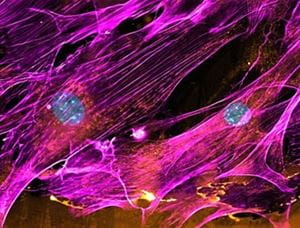
The laboratory of Nur P. Damayanti, PhD researches multi-omics approaches and patient-derived models to obtain precision medicine for rare gliomas patients, specifically, but not limited to, Pleomorphic Xanthoastrocytoma (PXA) and its anaplastic form (APXA). Her works involve model establishment, molecular characterization, biomarker identification, tumor classification and targeted therapy validation. The Damayanti Lab's first bona fide anaplastic glioma model was developed from a leptomeningeal spread of APXA from a patient treated at Riley Hospital for Children at IU Health. Integrated omics validate the fidelity between the patient’s tumor and its models (patient-derived xenograft, xenoline and spheroid) in histology as well as its molecular landscape at genomic, transcriptomic, proteomic, and post-translational level. In their ongoing effort, Damayanti and her team identified multiple therapeutic vulnerabilities as potential targets and continue to work to validate its preclinical benefit.
Active Research
Anaplastic Pleomorphic xanthoastrocytoma (APXA) is a rare cancer, accounting for less than 1% of all primary brain tumors. Its incidence of fewer than one person per year in the United State. APXA is an aggressive subset of Pleomorphic xanthoastrocytoma (PXA), itself a rare subtype of glioma that can sometimes progresses to glioblastoma. The 5-year overall survival (OS) rate for APXA is poor at 57%, and there is currently no standard of care. Surgical resection is most important for curative treatment but is not always feasible. The rarity of both PXA and APXA resulting in the paucity of targeted therapies and lack of substantial research on APXA. Therefore, there is a critical need to identify actionable targets that can pave the way for the development of novel treatments aimed at curing APXA patients. Investigating potential molecular targets in APXA could offer valuable insights into the development of more targeted and effective therapies, potentially improving the prognosis for patients facing this challenging diagnosis.
The long-term goal of the Damayanti Lab is to develop safe and translatable therapeutic strategy aimed at preventing disease progression and tumor resistance thereby improving quality of life and enhance survival outcome in PXA/APXA patients. To achieve their goal, the lab's effort includes, but is not limited to, establishing novel relevant preclinical model of APXA; and leveraging multi-faceted approach to explore and exploit novel therapeutic vulnerability which can lead to the development of novel treatment of PXA/PXA. In their ongoing research, the Damayanti Lab has established developed and characterized novel preclinical PDX model from a patient diagnosed with APXA at IU Health. Integrative multi-omics confirmed that the PDX model faithfully recapitulates the molecular signatures of the patient’s tumor specifically homozygous loss of CDKN2A/B fusion of the genes CDC42SE and BRAF at chromosomal loci 5q31.1 and 7q34. Additionally, the Damayanti Lab has expanded their model repertoire in collaboration with the Department of Neurosurgery at Duke University. Furthermore, integrative omics also identified MAPK as therapeutic target in this model, leading the lab to test therapeutic strategies targeting this pathway, which includes vertical and horizonal inhibition and intercascade inhibition.
Significantly, the Damayanti Lab has recently secured an industry partnership collaborative grant with Day One Biopharmaceuticals. This collaboration aims to assess the efficacy of monotherapy using tovorafenib, a next-generation BRAF inhibitor, within the APXA model. Tovorafenib is currently being evaluated in the Firefly-1, Firefly-2, and Firelight-1 trials. This partnership underscores the lab's dedicated mission to find a cure for this rare brain tumor and aligns seamlessly with research objectives.
Research Funding/Grants
ACS IRG-19-144-3. American Cancer Society Institutional Research Grant. Damayanti (PI). "Targeting BRAF and MEK in pediatric brain tumor models with different BRAF landscapes."
Day One Biopharmaceutical, industry partnership collaborative grant. Damayanti (PI). "Monotherapy assessment of tovoravenib in anaplastic pleomorphic xanthoastrocytoma patient derived model bearing BRAF fusion."
Recent Publications
Damayanti NP, et al. Establishment and characterization of patient-derived xenograft of a rare pediatric anaplastic pleomorphic xanthoastrocytoma (PXA) bearing a CDC42SE2-BRAF fusion. Sci Rep 13 (1), 9163, (2023).
Damayanti, NP, et al. SHP2 inhibition enhances antitumor effect of mirdametinib in a pediatric brain tumor model bearing CDC42SE2BRAF fusion by rewiring the proteome and phosphoproteome landscape. Cancer Research 83, 5498-5498, (2023).
Josue D Ordaz, Anthony Alfonso, Steven Bray, Mark S. Marshall, Alexander Vortmeyer, Jeffrey Raskin, Alex lion, Michael J. FergusonKarl E. Balsara, Karen E Pollok, Damayanti, NP. Single- institution retrospective study in the pediatric population at Indiana University: Clinical and molecular characterization of pleomorphic xanthoastrocytoma with and without anaplastic features. Proceeding of Indiana University Cancer Research Day. 2023.
Pandya, P. H., Jannu, A. J., Bijangi-Vishehsaraei, K., Dobrota, E., Bailey, B. J., Barghi, F., Shannon, H. E., Riyahi, N., Damayanti, NP, et al. Integrative Multi-OMICs Identifies Therapeutic Response Biomarkers and Confirms Fidelity of Clinically Annotated, Serially Passaged Patient- Derived Xenografts Established from Primary and Metastatic Pediatric and AYA Solid Tumors. Cancers (Basel), 15(1). (2022).